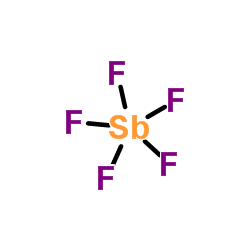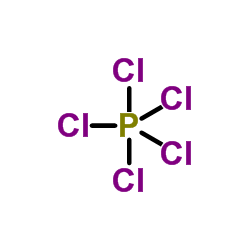7783-77-9
| Name | molybdenum hexafluoride |
|---|---|
| Synonyms |
Mo hexafluoride
Molybdenum fluoride (MoF6),(OC-6-11) hexafluoromolybdenum MFCD00014220 EINECS 232-026-5 molybdenum(6+) fluoride molybdenum(VI) fluoride MoF6 molybdenum(VI) hexafluoride Molybdenum fluoride (MoF6) molybdenum fluoride |
| Density | 2.3 g/mL at 25 °C(lit.) |
|---|---|
| Boiling Point | 37 °C(lit.) |
| Melting Point | 17.5 °C(lit.) |
| Molecular Formula | F6Mo |
| Molecular Weight | 209.95000 |
| Flash Point | 35°CC |
| Exact Mass | 211.89600 |
| LogP | 2.52120 |
Synonym:None Section 2 - COMPOSITION, INFORMATION ON INGREDIENTS
Risk Phrases: 32 34 Section 3 - HAZARDS IDENTIFICATION EMERGENCY OVERVIEW
Contact with acids liberates very toxic gas. Causes burns.Moisture sensitive.Corrosive. Potential Health Effects Eye: Causes eye burns. May cause chemical conjunctivitis and corneal damage. Skin: Causes skin burns. May penetrate the skin and cause severe tissue and bone destruction. May cause skin rash (in milder cases), and cold and clammy skin with cyanosis or pale color. Ingestion: May cause severe and permanent damage to the digestive tract. Causes gastrointestinal tract burns. May cause perforation of the digestive tract. Ingestion of large amounts of fluoride may cause salivation, nausea, vomiting, abdominal pain, fever, labored breathing. Exposure to fluoride compounds can result in systemic toxic effects on the heart, liver, and kidneys. It may also deplete calcium levels in the body leading to hypocalcemia and death. Contains fluoride. Inhalation: Causes chemical burns to the respiratory tract. Inhalation may be fatal as a result of spasm, inflammation, edema of the larynx and bronchi, chemical pneumonitis and pulmonary edema. Aspiration may lead to pulmonary edema. May cause systemic effects. Chronic: May cause liver and kidney damage. Effects may be delayed. Section 4 - FIRST AID MEASURES Eyes: Get medical aid immediately. Do NOT allow victim to rub eyes or keep eyes closed. Extensive irrigation with water is required (at least 30 minutes). Skin: Get medical aid immediately. Immediately flush skin with plenty of water for at least 15 minutes while removing contaminated clothing and shoes. Wash clothing before reuse. Destroy contaminated shoes. Ingestion: Do not induce vomiting. If victim is conscious and alert, give 2-4 cupfuls of milk or water. Get medical aid immediately. Inhalation: Get medical aid immediately. Remove from exposure and move to fresh air immediately. If not breathing, give artificial respiration. If breathing is difficult, give oxygen. Do NOT use mouth-to-mouth resuscitation. If breathing has ceased apply artificial respiration using oxygen and a suitable mechanical device such as a bag and a mask. Notes to Physician: Section 5 - FIRE FIGHTING MEASURES General Information: As in any fire, wear a self-contained breathing apparatus in pressure-demand, MSHA/NIOSH (approved or equivalent), and full protective gear. During a fire, irritating and highly toxic gases may be generated by thermal decomposition or combustion. Use water spray to keep fire-exposed containers cool. Use extinguishing media appropriate to the surrounding fire. Substance is noncombustible. May react with acids or moisture to form explosive hydrogen gas. Vapors may be heavier than air. They can spread along the ground and collect in low or confined areas. Containers may explode when heated. Extinguishing Media: Substance is noncombustible; use agent most appropriate to extinguish surrounding fire. Use dry chemical to fight fire. Do NOT get water inside containers. Cool containers with flooding quantities of water until well after fire is out. Section 6 - ACCIDENTAL RELEASE MEASURES General Information: Use proper personal protective equipment as indicated in Section 8. Spills/Leaks: Absorb spill with inert material (e.g. vermiculite, sand or earth), then place in suitable container. Avoid runoff into storm sewers and ditches which lead to waterways. Clean up spills immediately, observing precautions in the Protective Equipment section. Provide ventilation. Do not get water inside containers. Section 7 - HANDLING and STORAGE Handling: Keep container tightly closed. Do not get on skin or in eyes. Do not ingest or inhale. Use with adequate ventilation. Do not allow contact with water. This product may be under pressure; cool before opening. Discard contaminated shoes. Use caution when opening. Keep from contact with moist air and steam. Storage: Store in a cool, dry place. Store in a tightly closed container. Corrosives area. Keep away from acids. Store in metal containers. Store protected from moisture. Section 8 - EXPOSURE CONTROLS, PERSONAL PROTECTION Engineering Controls: Facilities storing or utilizing this material should be equipped with an eyewash facility and a safety shower. Use adequate ventilation to keep airborne concentrations low. Exposure Limits CAS# 7783-77-9: Personal Protective Equipment Eyes: Wear appropriate protective eyeglasses or chemical safety goggles as described by OSHA's eye and face protection regulations in 29 CFR 1910.133 or European Standard EN166. Skin: Wear appropriate protective gloves to prevent skin exposure. Clothing: Wear appropriate protective clothing to minimize contact with skin. Respirators: A respiratory protection program that meets OSHA's 29 CFR 1910.134 and ANSI Z88.2 requirements or European Standard EN 149 must be followed whenever workplace conditions warrant respirator use. Section 9 - PHYSICAL AND CHEMICAL PROPERTIES Physical State: Liquid Color: colorless Odor: pungent odor pH: Not available. Vapor Pressure: Not available. Viscosity: Not available. Boiling Point: 37 deg C Freezing/Melting Point: 17.5 deg C Autoignition Temperature: Not available. Flash Point: Not available. Explosion Limits, lower: Not available. Explosion Limits, upper: Not available. Decomposition Temperature: Solubility in water: Specific Gravity/Density: 2.3000g/cm3 Molecular Formula: MoF6 Molecular Weight: 209.93 Section 10 - STABILITY AND REACTIVITY Chemical Stability: Stable at room temperature in closed containers under normal storage and handling conditions. Contact with acid liberates gas. Conditions to Avoid: Incompatible materials, moisture, exposure to air, acids, exposure to moist air or water. Incompatibilities with Other Materials: Moisture, acids, acidic conditions, strong bases, strong oxidizing agents, strong reducing agents. Hazardous Decomposition Products: Carbon monoxide, irritating and toxic fumes and gases, carbon dioxide, hydrogen fluoride gas. Hazardous Polymerization: Has not been reported Section 11 - TOXICOLOGICAL INFORMATION RTECS#: CAS# 7783-77-9: QA4681450 LD50/LC50: CAS# 7783-77-9: Inhalation, mouse: LC50 = 339 mg/m3; Inhalation, rat: LC50 = 333 mg/m3. Carcinogenicity: Molybdenum(VI) Fluoride - Not listed by ACGIH, IARC, or NTP. Other: See actual entry in RTECS for complete information. Section 12 - ECOLOGICAL INFORMATION Section 13 - DISPOSAL CONSIDERATIONS Dispose of in a manner consistent with federal, state, and local regulations. Section 14 - TRANSPORT INFORMATION IATA Shipping Name: CORROSIVE LIQUID, N.O.S.* Hazard Class: 8 UN Number: 1760 Packing Group: II IMO Shipping Name: CORROSIVE LIQUID, N.O.S. Hazard Class: 8 UN Number: 1760 Packing Group: II RID/ADR Shipping Name: CORROSIVE LIQUID, N.O.S. Hazard Class: 8 UN Number: 1760 Packing group: II Section 15 - REGULATORY INFORMATION European/International Regulations European Labeling in Accordance with EC Directives Hazard Symbols: C Risk Phrases: R 32 Contact with acids liberates very toxic gas. R 34 Causes burns. Safety Phrases: S 25 Avoid contact with eyes. S 36/37/39 Wear suitable protective clothing, gloves and eye/face protection. S 45 In case of accident or if you feel unwell, seek medical advice immediately (show the label where possible). WGK (Water Danger/Protection) CAS# 7783-77-9: No information available. Canada CAS# 7783-77-9 is listed on Canada's NDSL List. CAS# 7783-77-9 is not listed on Canada's Ingredient Disclosure List. US FEDERAL TSCA CAS# 7783-77-9 is listed on the TSCA inventory. SECTION 16 - ADDITIONAL INFORMATION N/A |
| Hazard Codes | C |
|---|---|
| Risk Phrases | R34 |
| Safety Phrases | S26-S36/37/39-S45 |
| RIDADR | UN 3264 8/PG 2 |
| WGK Germany | 3 |
| RTECS | QA4681450 |
| Packaging Group | II |
| Hazard Class | 6.1 |
| Precursor 10 | |
|---|---|
| DownStream 10 | |

















